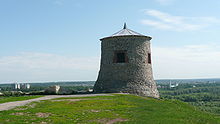Yelabuga
| city
Yelabuga
Elabuga
|
||||||||||||||||||||||||||||||||||||||
|
||||||||||||||||||||||||||||||||||||||
|
||||||||||||||||||||||||||||||||||||||
| List of cities in Russia | ||||||||||||||||||||||||||||||||||||||
Yelabuga ( Russian Елабуга , Tatar Алабуга) is a city in the Russian republic of Tatarstan , located on the right bank of the Kama River . It lies on an area of 18.4 km² and is the center of the Rajons of the same name . The population is 70,728 (as of October 14, 2010).
story

The origins of Jelabuga are in the 11th century, when Volga Bulgarians built a border fortress here; the remains of the "Devil's Castle " (Tatar: Şaytan qalası , Russian Чёртово городище ) have been preserved to this day. In the 16th century, a Russian village was founded in what is now the city.
Yelabuga has had city rights since 1780.
The Soviet POW camp 97 for German POWs of the Second World War already existed in Yelabuga before the end of the Battle of Stalingrad . The first anti-fascist officer group was formed here under Captain Ernst Hadermann . From February 1943 mainly German officers were brought to Jelabuga, initially those captured in Stalingrad, and later also from other Red Army operations . In addition to German prisoners of war, members of the armies of nations allied with Germany were also interned in Jelabuga. Romanians, Italians, Hungarians and Japanese. There were two main NKVD camps in the city, No. 97A (Kama camp) and No. 97B (monastery camp), as well as several sub-camps in the surrounding forests.
Population development
| year | resident |
|---|---|
| 1897 | 9,764 |
| 1939 | 14,963 |
| 1959 | 21,992 |
| 1970 | 31,728 |
| 1979 | 35,574 |
| 1989 | 53,537 |
| 2002 | 68,663 |
| 2010 | 70,728 |
Note: census data
Personalities
In 1892 the Austrian chemist Carl Josef Bayer was looking for bauxite in Jelabuga and had an aluminum factory built here.
Yelabuga is the birthplace of the Russian painter Ivan Shishkin , the opera singer Asat Abbassow and the diplomat Gennady Gerasimow . The Russian poet Marina Tsvetaeva spent here in 1941 with her son, the last days of her life before suicide committed. In the city there is a museum about the life of the writer.
In January 1944 the German doctor Kurt Reuber , who became famous for his Stalingrad Madonna, died in a prison camp near Jelabuga , who - shortly before his death - drew a second version of his Madonna for the prisoner newspaper, the so-called "prisoner Madonna".
Quite a number of the officers prisoner of war in Jelabuga from 1943 onwards worked as a journalist after their return and also processed their memories from Tatarstan and Stalingrad, including the German writer Otfried Preußler (Buch Krabat ), the Jesuit and missionary Pietro who was captured by the Soviets as an Italian military chaplain Alagiani , Udo Giulini (later member of the German Bundestag and IHK President), Wigand Wüster (watercolors on Jelabuga and Stalingrad), Fritz Wöss (book The fish begins to stink on your head ) and Klaus Sasse ("The Königsberger", took away secretly a miniature camera in the warehouse).
Works by Otfried Preußler and Wigand Wüster can be found in the Jelabuga City Museum.
business
The Yelabuga Special Economic Zone is located in the north of the city . Ford Sollers, a joint venture between Ford and Sollers , operates an auto plant there. In the special economic zone there is also a factory for the production of floor coverings for the German Knauf Group . The factory was previously part of Armstrong World Industries .
Town twinning
-
 Safranbolu , Turkey
Safranbolu , Turkey -
 Alexin , Russia
Alexin , Russia -
 Beryozovsky , Russia
Beryozovsky , Russia -
 Weilheim in Upper Bavaria , Germany
Weilheim in Upper Bavaria , Germany
literature
- Walter Berger, Captured in a Foreign Country: This is how I experienced the Second World War and the Russian captivity , 2005
- Otto Rühle, convalescence in Jelabuga , 1967
- Klaus Sasse, pictures from Russian captivity: memories and photos from Yelabuga and other Soviet camps 1945–1949 , 2007
Individual evidence
- ↑ a b Itogi Vserossijskoj perepisi naselenija 2010 goda. Tom 1. Čislennostʹ i razmeščenie naselenija (Results of the All-Russian Census 2010. Volume 1. Number and distribution of the population). Tables 5 , pp. 12-209; 11 , pp. 312–979 (download from the website of the Federal Service for State Statistics of the Russian Federation)
- ↑ Maschke, Erich (ed.): On the history of the German prisoners of war of the Second World War. Verlag Ernst and Werner Gieseking, Bielefeld 1962–1977.
- ↑ Knauf takes over Armstrong's plant in Tatarstan , at www.owc.de , accessed on July 29, 2018
Web links
- Official website of the city of Yelabuga (Russian)
- Entry on mojgorod.ru (Russian)
- Yelabuga photo gallery




